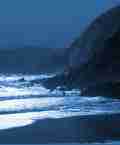 |
Search the site:

CONNEMARA & THE BURRENSome of our party (on Ben Lettery) called for the provision basket. It was little short of treason against the majesty of Nature, to fix those eyes on rolls and cold beef, which ought to have been directed to one of the noblest views of Cunnemarra.Though not really a highland area - the hills reach only 346 metres/I, 134 feet - the strange lunar-like karstic land-scape of the Burren (routes 100, 105) of north-west Clare is certainly worth a visit. From a distance, each hill looks like a stack of grey discs, each smaller than the one directly below it. Closer to, the limestone pavements across which one walks (beware of the numerous grooves in the rock) are short, crumbly, easily climbed cliffs. It is particularly rewarding to walk the Burren in May, when the numerous varieties of plants which thrive here are in bloom. The waymarked Burren Way takes in much of the area. There is a comparatively easy marathon walk in the Burren in August. Access: the N6 (Dublin to Galway road), the usual approach to Connemara, is fairly good, though the roads west of Galway are narrow and bumpy. Clifden, on the remote western out-skirts of the region, is about 300 kilometres/185 miles from Dublin; Lame is about 400 kilomclrcs/2;0 miles and Rosslare Harbour about 350 kilometres/215 miles away. Galway has the nearest railway station and a small airport. There are express buses to Clifden from Galway via Roundstone and from Westport via Leenane, both operating in the summer only. Roads and accommodation: travel by road within Connemara is surprisingly easy. The N59 runs near all the ranges and the R344 runs between the Maamturks and the Twelve Bens but is of little use for the latter because a line of lakes and a swathe of forest greatly impede an approach from the road. The biggest centre by far in Connemara is Clifden, though even it is modest. There are several other smaller centres, for instance Letterfrack and Recess. Tiny Leenane, as stated previously, is well placed for much of Connemara and equally well placed for the mountains of South Mayo. Local bus services follow variations of the express routes (they leave the N59 to call to surrounding villages) so that the region is generally quite well served by public transport. The Burren is quite easy to access, has several small towns close to it and has express bus services running through Ballyvaughan and Lisdoonvarna. The local bus service is quite poor. Though it may now be a little out of date, the Connemara mapfguillt cumains a lIlap at 1 :)0,000 which i~ explicilly designed for walkers. Its boundaries neatly encompass the three ranges in Connemara and it shows cliffs compre-hensively, the only map in the Republic to do so. For this reason, it is given as the reference map for the area it covers. Note that most mountain names are in Irish on this map and therefore unfamiliar to most walkers and indeed probably to locals (though it has to be said that locals probably find the English version unfamiliar!). Unfortunately, the paper used is flimsy and it would be worth while reinforcing it if it has to take more than minimal use. The Burren is covered by the usual half-inch map (sheet 14), but look out for r.D. Robinson's stylish map of the Burren on a scale of 1:35,200. It is uncontoured; escarpments and small-scale features are, however, shown and these make it quite adequate for walkers. Route 92: South Twelve Bens-Gleann Chochan Horseshoe Connemara map (1 :50,000). Start at Ben Lettery Youth Hostel on N59 (L 777483). Climb Ben Lettery/Binn Leitri directly from youth hostel; climb Binn Gabhar. Climb Binn Bhraoin by easily avoidable scree slope, walk along summit plateau north, then north-east and take steep rocky descent north-east (not east) to col at Mam Eidhneach (L 788527) (escape possible here but make for track at L 806501 to minimise wet ground). Climb Bencollaghduff, descend to col at Mam na bhFonsai, climb east, then south-east to Binn Chorf. Climb Derryclare and, to avoid cliffs to right, continue south for 1.5 kilometres before veering right to pick up track. If, alas, there is no transport here, walk track for two kilometres and N59 for 1.5 kilometres. Distance: 16 kilometres. Climb: 1,600 metres. Time: 7.5 hours (including 1.5 hours for steep descents). Connemara map (1:50,000). A short introductory walk in the Bens is to take the above route to Binn Gabhar, retrace steps to cairn between it and Ben Lettery and climb Binn Ghleann Uisce. Descend west to forest (shown much higher on map than in reality) and follow it to track. Track and N59 to start. Distance: 10 kilometres. Climb: 700 metres. Time: 3.25 hours. The next 'Connemara & the Burren' extract can be found here : Part 3
|
[ Back to Top ]
All Material © 1999-2009 Irelandseye.com and contributors
